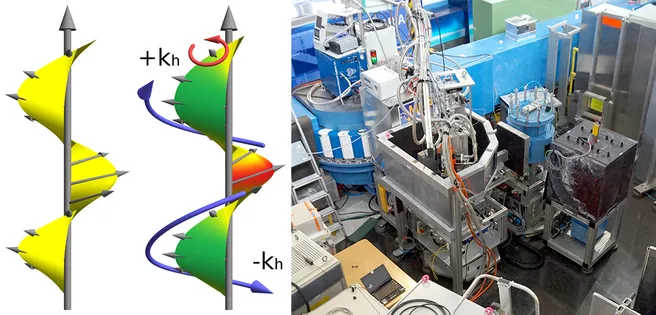29.08.2015
Manganese silicon is the preferred crystal of scientists going in for magnetic research: it can be manufactured for some time as relatively large single crystal, and is particularly suited to investigate the magnetic properties. Now theoretical and experimental physicists from the TU Munich, the MLZ and the University of Cologne managed to pull off a special coup with this material.
Seen from outside Manganese silicon shows no magnetism, inside it looks different. Through a special symmetry of the crystal structure a spiral structure of the magnetic moments, a magnetic helix, is created in the interaction with the classical exchange interaction in magnets. This is much longer than the typical distance between two atomic layers of the crystal lattice.
By neutron scattering TU scientists have now proven these excitations of this helix. Theorists of the University of Cologne had already predicted that there should be several of these excitations, which can be identified with a longitudinal vibration and two torsional vibrations on the spiral. However, such a structure could not be proved experimentally. At the Physics Department of the TUM these excitations now were measured with microwaves and at the MLZ with neutrons. The MLZ scientist Max Kugler and Georg Brandl, who graduate with these experiments and the instrument scientist Robert Georgii and Klaus Seemann have modified the instrument MIRA at the FRM II in a way that also three-axis measurements are possible and so the excitations of the helical magnetic structure could be detected. The theorists have thereby already established a mathematical calculation model that describes these vibrations for all helical magnets and contains only simple measurable material parameters. In the future, it is therefore possible to determine the oscillations of the magnetic moments of a helical crystal purely mathematical and without expensive neutron scattering. It only needs a few parameters that can be measured with a simple magnetometer in every lab and then entered into the formula.
Robert Georgii is enthusiastic about the experiment: "This is a wonderful example of the success of basic research! However, I've rarely seen an experiment that works right away and has delivered so unequivocal results, which in turn is due to the close collaboration between theory and experiment. "
Original publications:
M. Kugler, G. Brandl, J. Waizner, M. Janoschek, R. Georgii, A. Bauer, K. Seemann, A. Rosch, C. Pfleiderer, P. Böni, and M. Garst; Band structure of helimagnons in MnSi resolved by inelastic neutron scattering; Physical Review Letter 115, 097203 (2015)
T. Schwarze, J. Waizner, M. Garst, A. Bauer, I. Stasinopoulos, H. Berger, C. Pfleiderer & D. Grundler; Universal helimagnon and skyrmion excitationsin metallic, semiconducting and insulating chiral magnets; Nature Materials 14, 478–483 (2015)
